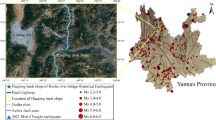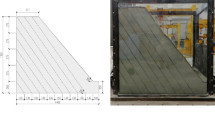Abstract
Stability prediction of rock slope under seismic loads is important for landslide hazard assessment. For studying the dynamic response of anti-dip rock slope, one two-dimensional physical model of anti-dip slope containing two groups of rock joints was designed for shaking table test. The influences of different dynamic parameters including wave type, amplitude and frequency on the dynamic response of the slope model were considered. The results of this study reveal that the amplification coefficients of peak ground acceleration increase with increasing the relative elevation. With the increase of acceleration amplitude, the amplification coefficients rise on the whole, but they are influenced by rock structure and wave type. The amplification coefficients increase with the increase of frequency, and they become stronger near the slope top. The influence of frequency is closely related to the acceleration amplitude. The discontinuous deformation analysis method was used to compare the dynamic failure of slope model with shaking table test. Both the results of two methods indicate that the slope model under seismic loads mainly presented that shear cracks and tension cracks extended, connected and developed step-type fractures, the slope experienced toppling and sliding failure. The study has theoretical and practical significance, it can provide guidance for seismic slope engineering.









Similar content being viewed by others
References
Abe K, Nakamura S, Nakamura H, Shiomi K (2017) Numerical study on dynamic behavior of slope models including weak layers from deformation to failure using material point method. Soils Found 57(2):155–175
Aydan Ö (2006) Geological and seismological aspects of Kashmir earthquake of October 8, 2005 and geotechnical evaluation of induced failures of natural and cut slopes. J Sch Marine Sci Technol Tokai Univ 4(1):25–44
Aydan Ö (2016) Large rock slope failures induced by recent earthquakes. Rock Mech Rock Eng 49(6):2503–2524
Che A, Yang HK, Wang B, Ge XR (2016) Wave propagations through jointed rock masses and their effects on the stability of slopes. Eng Geol 201:45–56
Chen ZL, Hu X, Xu Q (2016) Experimental study of motion characteristics of rock slopes with weak intercalation under seismic excitation. J Mt Sci (Engl) 13(3):546–556
Curtis WD, Logan JD, Parker WA (1982) Dimensional analysis and the pi theorem. Linear Algebra Appl 47:117–126
Fan G, Zhang JJ, Wu JB, Yan KM (2016) Dynamic response and dynamic failure mode of a weak intercalated rock slope using a shaking table. Rock Mech Rock Eng 49(8):1–14
Fu XD, Sheng Q, Zhang YH, Zhou YQ, Dai F (2015) Boundary setting method for the seismic dynamic response analysis of engineering rock mass structures using the discontinuous deformation analysis method. Int J Numer Anal Meth Geomech 39(15):1693–1712
Hatzor YH, Feintuch A (2001) The validity of dynamic block displacement prediction using DDA. Int J Rock Mech Min Sci 38(4):599–606
Huang R, Li W (2009) Development and distribution of geohazards triggered by the 5.12 Wenchuan earthquake in China. Sci China Ser E: Technol Sci 52(4):810–819
Huang RQ, Zhao JJ, Ju NP, Li G, Min LL, Li YR (2013) Analysis of an anti-dip landslide triggered by the 2008 Wenchuan earthquake in China. Nat Hazards 68(2):1021–1039
Kamai T, Wang WN, Shuzui H (2002) The landslide disaster induced by the Taiwan Chi-Chi earthquake of 21 September 1999. Landslide News 13:8–12
Liu HX, Xu Q, Li YR, Fan XM (2013) Response of high-strength rock slope to seismic waves in a shaking table test. Bull Seismol Soc Am 103(6):3012–3025
Liu X, He C, Liu S, Liu Y, Lu Y, Liu Z (2018) Dynamic response and failure mode of slopes with horizontal soft and hard interbeddings under frequent microseisms. Arab J Sci Eng 43(10):5397–5411
Louis B (1957) The Pi theorem of dimensional analysis. Arch Ration Mech Anal 1(1):35–45
Lv Q, Liu YR, Yang Q (2017) Stability analysis of earthquake-induced rock slope based on back analysis of shear strength parameters of rock mass. Eng Geol 228(10):39–49
MacLaughlin MM, Doolin DM (2006) Review of validation of the discontinuous deformation analysis (DDA) method. Int J Numer Anal Meth Geomech 30(4):271–305
Ning YJ, Zhao ZY (2013) A detailed investigation of block dynamic sliding by the discontinuous deformation analysis. Int J Numer Anal Methods Geomech 37(15):2373–2393
Shi GH (1988) Discontinuous deformation analysis-a new numerical model for the statics and dynamics of block system. PhD thesis, University of California, Berkeley
Shi GH, Good RE (1985) Two dimensional discontinuous deformation analysis. Int J Numer Anal Meth Geomech 9(6):541–556
Tsesarsky M, Hatzor YH, Sitar N (2005) Dynamic displacement of a block on an inclined plane: analytical, experimental and DDA results. Rock Mech Rock Eng 38(2):153–167
Wang KL, Lin ML (2011) Initiation and displacement of landslide induced by earthquake: a study of shaking table model slope test. Eng Geol 122(1):106–114
Wartman J, Seed RB, Bray JD (2005) Shaking table modeling of seismically induced deformations in slopes. J Geotech Geoenviron Eng 131(5):610–622
Wu JH (2010) Seismic landslide simulations in discontinuous deformation analysis. Comput Geotech 37(5):594–601
Wu JH, Chen CH (2011) Application of DDA to simulate characteristics of the Tsaoling landslide. Comput Geotech 38(15):741–750
Wu JH, Lin J, Chen C (2009) Dynamic discrete analysis of an earthquake-induced largescale landslide. Int J Rock Mech Min Sci 46(2):397–407
Xia SY, Zhang CF, Zhang MZ (1980) Discussion on several issues of dynamic structure model similar conditions. J Hohai Univ (Nat Sci Ed) 1:59–72 (in Chinese)
Xu Q, Liu H (2013) Topographic effect on seismic slope behavior in a shaking table test. In: Ugai K, Yagi H, Wakai A (eds) Earthquake-induced landslides. Springer, Berlin
Xu Q, Liu HX, Zou W, Fan XM, Chen JJ (2010) Large-scale shaking table test study of acceleration dynamic responses characteristics of slopes. Chin J Rock Mechan Eng 29(12):2420–2428
Yang CW, Zhang JJ, Liu FC, Bi JW, Zhang J (2015) Analysis on two typical landslide hazard phenomena in the Wenchuan earthquake by field investigations and shaking table tests. Int J Environ Res Public Health 12(8):9181–9198
Zhang Y, Chen G, Wu J, Zheng L, Zhuang X (2012) Numerical simulation of seismic slope stability analysis based on tension-shear failure mechanism. Geotech Eng 43(2):18–28
Zhang YB, Chen GQ, Zheng L, Wu J (2013) Effects of near-fault seismic loadings on run-out of large-scale landslide: a case study. Eng Geol 166(8):216–236
Zhang YH, Fu XD, Sheng Q (2014) Modification of the discontinuous deformation analysis method and its application to seismic response analysis of large underground caverns. Tunn Undergr Space Technol Inc Trenchless Technol Res 40(1):241–250
Zhao MS, Huang D, Cao MS, Qiao JP (2015) Shaking table tests on deformation and failure mechanisms of seismic slope. J VibroEng 17(1):1392–8716
Acknowledgements
The work reported in this paper has received financial support from the National Natural Science Foundation of China (No. 51679173, U1765207) and Natural Science Foundation of Hubei Province (No. 2016CFA083). This support is gratefully acknowledged. The authors would like to express appreciation to the anonymous reviewers for their valuable comments and suggestions for improving this manuscript.
Author information
Authors and Affiliations
Corresponding author
Rights and permissions
About this article
Cite this article
Feng, X., Jiang, Q., Zhang, X. et al. Shaking Table Model Test on the Dynamic Response of Anti-dip Rock Slope. Geotech Geol Eng 37, 1211–1221 (2019). https://doi.org/10.1007/s10706-018-0679-4
Received:
Accepted:
Published:
Issue Date:
DOI: https://doi.org/10.1007/s10706-018-0679-4




